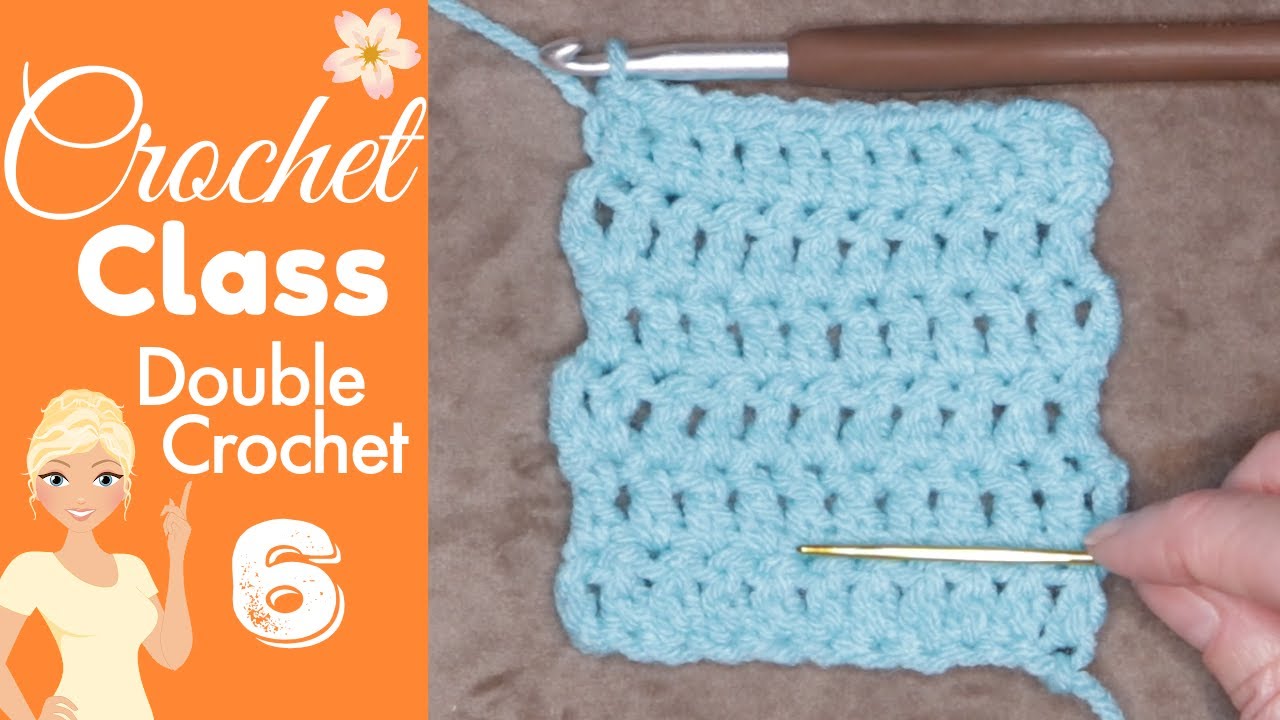
Crochet Class 6: Easy Double Crochet Stitch Tutorial!
When I first started learning crochet, the double crochet stitch felt like a game changer. It's taller than a single crochet, works up faster, and creates beautiful texture. In this crochet class for beginners, I'll walk you through every step to nail this essential stitch while making a simple coaster.
Table of contents
What You Need to Get Started
Before we dive in, let's gather our supplies:
- Worsted weight yarn - I'm using Saver from Icy Yarns
- 6mm crochet hook (also called a J hook)
- Two stitch markers - These help track your first and last stitches
- Yarn needle - For weaving in ends when we're done
- Scissors
If you tend to crochet tightly, consider using a slightly larger hook just for your starting chain. This prevents the foundation from being too tight to work into later.
Creating the Foundation Chain
Every crochet project starts with a slip knot. Here's how I make mine:
- Lay the yarn tail over my non-dominant hand
- Hold it down while wrapping around two fingers to make an X
- Poke the working yarn under the loop
- Pull it up gently and adjust the size
Now chain 10. I don't pull my yarn tightly - those chains should stay relaxed. Count the little V shapes (not counting the knot or what's on your hook). You should have 10 chains when you're done. If you're short, don't worry. Just carefully unravel and try again.
Preparing for Double Crochet
The double crochet stitch is taller than others we've learned, so we need to create some height first. Chain 3 more. This gives us the same height our double crochets will have. Those three chains count as our first "stitch" in many patterns, though for this project, we won't count them that way.
Working Your First Double Crochet
Find the fourth chain from your hook (counting the one on your hook as "zero"). Insert your hook under just the back bump - that's the little ridge on the back of each chain. You might need to roll your chain slightly to see it clearly.
Here's the double crochet breakdown:
- Yarn over (wrap yarn around your hook)
- Insert hook into the stitch
- Yarn over and pull up a loop (you'll have three loops on your hook)
- Yarn over and pull through two loops (down to two loops)
- Yarn over and pull through remaining two loops
That's one double crochet complete! Mark this first stitch with a stitch marker so we can find it again easily. I put mine under both strands of the V at the top of the stitch.
Continuing Across the Row
Work one double crochet into each remaining chain. Keep an eye out for those back bumps - they can hide sometimes! If your hook won't go through easily, your starting chain might be too tight. That's why I suggested using a larger hook just for the foundation.
When you reach the end, make sure to put your final double crochet into that last chain. Mark this stitch too, because our edges can get tricky to identify later.
Turning Your Work and Starting Row 2
Chain 3 (this gives us height for the new row) and turn your work. The double crochet in the marked stitch will be our first stitch of the new row. Remove the marker temporarily if it's in your way.
Work one double crochet into each stitch across. The tops of your double crochets make little "dimples" that are easy to spot once you know what to look for. When you reach the end, your last stitch will be into that marked stitch from the previous row. Move your marker up to mark this new stitch.
Building Your Coaster
Continue this pattern until you have six full rows. Here's how to count your rows:
- Each horizontal line of V's counts as one row
- The starting chain doesn't count as a row
- Your turning chains create a little bump that might look like an extra row, but they're part of the row below them
Finishing Off
When you've completed six rows:
- Chain 1 (a smaller chain than we've been doing)
- Cut your yarn, leaving about 6 inches for weaving
- Pull the yarn through to secure the last stitch
- Use your yarn needle to weave in both ends
Troubleshooting Common Issues
Many beginners notice their edges look bumpy from the chain-3 turning chains. If you prefer cleaner edges, try:
- Using a chain-2 instead (still works for double crochet height)
- Trying an alternative turning method (we'll cover this in a future class)
Remember, this pattern uses chain-3 because most patterns do. It's good to practice the standard before exploring alternatives.
What's Next in Your Crochet Journey?
Now that you've mastered the double crochet, you're ready for so many projects! This stitch creates beautiful blankets, scarves, and more. I'd love to see photos of your finished coasters - share them with our crochet community.
Looking for more beginner-friendly projects? Check out my [Easy Crochet Blanket Ideas]https://secretyarnery.com/blogs/patterns/10-quick-and-easy-crochet-blanket-pattern-for-beginners) that build on these skills. Keep practicing, and soon these stitches will feel completely natural.
Learning the double crochet stitch is a big step for any beginner crocheter. With this simple project, you’ve built skills that open the door to many new patterns and ideas. Practice this stitch until it feels natural, and don’t hesitate to try more challenging projects as your confidence grows. Each row and project will help you improve. Keep your tools nearby, enjoy the creative process, and share your work with others. Happy crocheting!
FAQs
What is the difference between single crochet and double crochet
Single crochet is shorter and creates a tighter fabric. Double crochet is taller, works up faster, and gives a looser, more textured look.
Why does my starting chain feel tight
If your foundation chain is tight, use a larger hook to make it. This gives your first row more stretch and makes it easier to work your stitches.
Do I always count the turning chain as a stitch in double crochet
Not always. Some patterns count the turning chain, some don’t. For this project, the turning chain is not counted as a stitch.
My edges look bumpy. What am I doing wrong
Bumpy edges are common for beginners. Double-check that you’re working into the last stitch at the end of each row and not missing or adding stitches.
How do I keep my row count accurate
Use stitch markers to mark the first and last stitches of your row, and count your rows by the V-shaped lines in your work.
Can I use a different yarn or hook size
Yes! Just remember, changing your yarn or hook will change the coaster’s size and texture.





